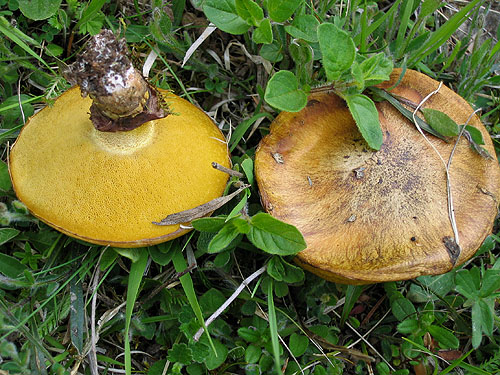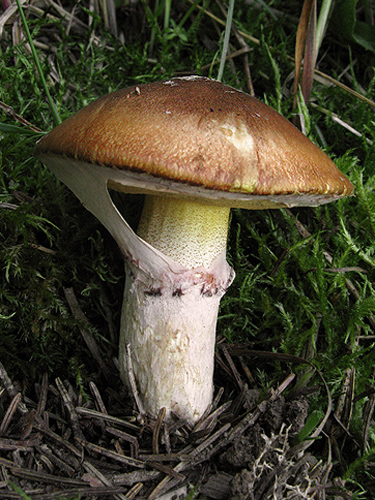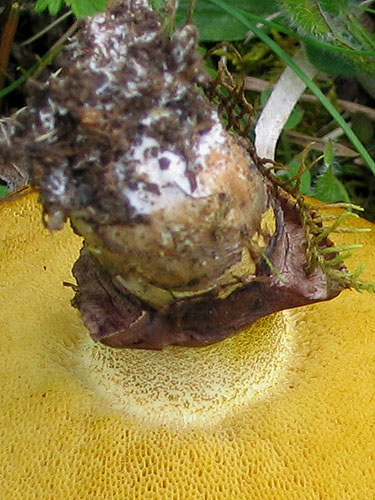Suillus Adans.
A number of species are known in Europe. Fruitbody boletoid without or with partial veil, and then leaving a ring on the stipe. Cap in most species more or less viscid. Stipe solid.
Suillus luteus (L. : Fr.) Roussel
Description
Fruitbodies with partial veil, soon disrupting and leaving distinct ring on the stipe surface. Cap up to 12 cm, at first hemispherical then expanding to convex, brown to dark brown, sometimes fading to ochraceous, viscid when wet. Stipe, cylindrical or clavate, more or less whitish or yellowish, with dark coloured ring, covered with numerous small whitish to brownish glandular dots; stipe base and the basal mycelium whitish. Flesh whitish to yellowish. Tubes pale yellow to olivaceous yellow. Pores fine, rounded, pale yellow to olivaceous yellow. Smell not distinctive. Taste not distinctive. Spores 8–10.5 × 3–3.5 μm.
Habitat. Coniferous or mixed forests, artificial plantations, mycorrhizal with pines (Pinus).
Distribution. In Europe extremely widespread and common.
Similarity. Probably might be sometimes confused with Suillus collinitus due to the similarly coloured fruitbodies, the later however has no ring and shows pinkish basal mycelium.
Photographs

Fruitbodies of Suillus luteus. (photo B. Assyov)

Suillus luteus - young fruitbody with torn partial veil that will leave a ring on the stipe. (photo I. Assyova)

Fruitbody of Suillus luteus

Suillus luteus - detail of the stipe with well visible violaceous ring. Note also the granulations between the ring and the tubes. (photo B. Assyov)
Important literature
Alessio, C.L. 1985. Boletus Dill. ex L. (sensu lato). – In: Fungi Europaei. Vol. 2. Pp. 1–705. Libreria editrice Biella Giovanna, Saronno.
Breitenbach J. & Kränzlin F. 1991. Pilze der Schweiz. Bd. 3(1). Röhrlinge und Blätterpilze. Verlag Mykologia, Luzern.
Engel, H., Dermek, A., Klofac, W., Ludwig, E. & Brückner, T. 1996. Schmier – und Filzröhrlinge s. l. in Europa. Die Gattungen Boletellus, Boletinus, Phylloporus, Suillus, Xerocomus. Verlag Heinz Engel, Weidhausen b. Coburg.
Estadès, A. & Lannoy, G. 2004. Les bolets européens. – Bulletin Mycologique et Botanique Dauphiné-Savoie 44(3): 3–79.
Galli, R. 1998. I Boleti. Atlante pratico-monographico per la determinazione dei boleti. Edinatura, Milano.
Hansen, L. & Knudsen, H. 1992. Nordic Macromycetes. Vol. 2. Polyporales, Boletales, Agaricales, Russulales. Nordsvamp, Copenhagen.
Knudsen, H. & Vesterholt, J. [eds.]. 2008. Funga Nordica. Nordsvamp, Kopenhagen.
Lannoy, G. & Estadès, A. 2001. Les Bolets. Flore mycologique d’Europe. Documents Mycologiques Mémoire Hors série no. 6. Pp. 1–163. Association d’Écologie et de Mycologie, Lille.
Muñoz, J.A. 2005. Boletus s. l. – In: Fungi Europaei. Vol. 1. Pp. 1–951. Edizioni Candusso, Alassio.
Pilát, A. & Dermek, A. 1974. Hríbovité huby. Československé hríbovité a sliziakovité huby (Boletaceae – Gomphidiaceae). Veda, Bratislava.
Šutara, J., Mikšík, M. & Janda, V. 2009. Hřibovité houby. Čeled’ Boletaceae a rody Gyrodon, Gyroporus, Boletinus a Suillus. Academia, Praha.
Watling, R. 1970. Boletaceae, Gomphidiaceae, Paxillaceae. – In: Henderson, D.M., Orton, P.D. & Watling, R. [eds]. British fungus flora. Agarics and Boleti. Vol. 1. Royal Botanic Garden, Edinburgh.
Watling, R. & Hills, A.E. 2005. Boletes and their allies (revised and enlarged edition). – In: Henderson, D.M., Orton, P.D. & Watling, R. [eds]. British Fungus Flora. Agarics and boleti. Vol. 1. Royal Botanic Garden, Edinburgh.